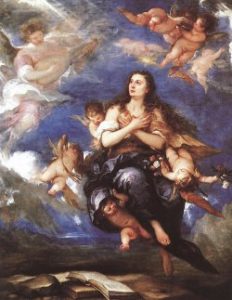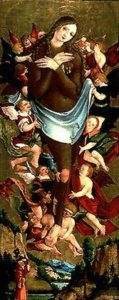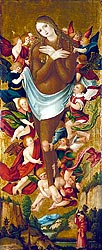 Day 14: MM’s Assumption of Magdalene byAntolinez
Day 14: MM’s Assumption of Magdalene byAntolinez
 Art: Mary was said to have been taken up into heaven on a daily basis during her years of seclusion. Here we see her assumption,and she appears to be talking with angels like the Giotto painting on the cover of Leloup’s Gospel of Mary Magdalene. Pictured left. Note her attire (or lack thereof!), her hair.
Art: Mary was said to have been taken up into heaven on a daily basis during her years of seclusion. Here we see her assumption,and she appears to be talking with angels like the Giotto painting on the cover of Leloup’s Gospel of Mary Magdalene. Pictured left. Note her attire (or lack thereof!), her hair.
Devotional: Was this idea of the Magdala’s assumption necessary for her legend to continue? Does this idea bother you or intrigue you? And how does it affect the Magdala’s example as a woman who had a unique relationship with God? Does it make her more or less accessible to everyday folks? [Katia’s two cents worth: There are several paintings showing Mary Magdalene’s assumption up to heaven after her physical death. I prefer to think of her as partner to Yeshua in all things, including their joint mission. This might require them both to ascend (rather than an assumption)up to heaven and “sit”. Then again, since Yeshua is a male, and male gods are associated with heaven and the sky, perhaps only he ascended and she remained among mankind, since female deities are often associated with the earth. One gnostic teaching has Yeshua remaining with her (and their students) after the Resurrection for eleven years. I like to think of them both ascending after getting their child/children safely raised and housed. Of course this conflicts somewhat with another attractive theory in which Magdalene remains among us, born generation after generation into some female. Sophia is also said to be among us in this fashion, was probably in Simon Magus’ Helen. Even more attractive is the idea that Sophia is “every woman.” Each female might be a manifestation Sophia, Magdalene or simply a “Goddess” manifestation. So all women are able to access and actualize Her. The opposite might be true of males, they are each a manifestation of the masculine Divine, be it Creator or Redeemer. When the ego falsely identifies with Goddess or God is when you get megalomania and “messiah complex.” It is the spirit, not the personality or ego, that is a manifestation of the Divine.]
 Elevation of the Magdalen by Peter Strub
Elevation of the Magdalen by Peter Strub
Here are some notes about this painting which I found online, I am not sure where:
Peter Strüb’s (stroob) painting The Elevation of the Magdalen shows Mary, covered with hair, being lifted up by 14 angels. A golden halo surrounds her idealistically youthful face, which shows no signs of her 30-year stay in the wilderness. Her abundantly flowing red hair is a common ATTRIBUTE, referring to her humble drying of Jesus’ feet. Far less typical is the animal-like fur that covers much of her idealized body. Mary folds her hands over her chest, which is not covered by fur. Her knees are also exposed, all hair evidently worn away from kneeling in constant prayer. The angels discreetly cover her lower abdomen with a crisply draped cloth. From the mountainous landscape below, a priest looks up at the miraculous vision.
Style: Peter Strüb’s tempera painting The Elevation of the Magdalen is for the most part typical of German Renaissance art. The flat gold BACKGROUND, a characteristic feature of medieval art, remained a popular tradition in religious painting well into the Renaissance. The gold suggests that the subject is holy and bathed in heavenly light. By contrast, the detailed landscape below Mary is very much a part of the earthly realm. Typical of German painters of his era who rendered their native landscape in great detail, Strüb painted Mary Magdalene in a mountainous German landscape, rather than in southern France. Fine realistic details abound, from the leafy trees and craggy rocks to the individual hairs of Mary’s fur suit and the soft feathers of the angels’ wings. This attention to detail is one of the most characteristic traits of German Renaissance art.

Easy Lab Report Form
Contemplation Lab Main Page
1 2 3 4 5 6 7 8 9 10 11 12 13 14 15

